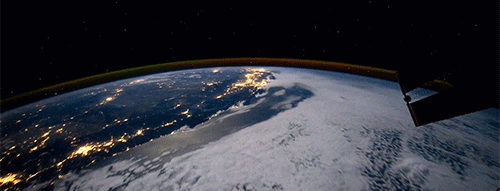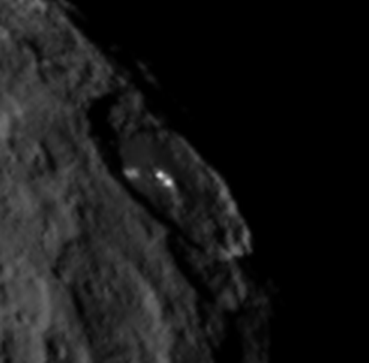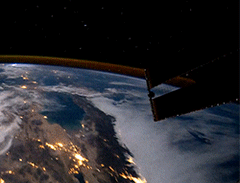It looks like you're using an Ad Blocker.
Please white-list or disable AboveTopSecret.com in your ad-blocking tool.
Thank you.
Some features of ATS will be disabled while you continue to use an ad-blocker.
share:
a reply to: Kapusta
those are lights
look familiar?
wildlydistorted.tumblr.com...
those are lights
look familiar?
edit on 16-5-2015 by grey580 because: (no reason given)
wildlydistorted.tumblr.com...
edit on 16-5-2015 by grey580 because: (no reason given)
originally posted by: MysterX
For those very bright areas to be snow or ice, it would have to be reflecting the light from the sun..and if it were doing that, the intensity and apparent luminosity would change as the ice angled away from the glare of the sun...it doesn't appear to do so, instead remaining as close to being a constant brightness as my eyes can gauge.
It's not necessarily true that the luminosity does not vary as the sun angle changes. As ATS member ApMaP pointed out earlier in this thread, the white pixels we see may not be the actual color data from Ceres, but rather it smay be a case of the image sensors being overloaded, and those sensors returning the data in those pixels as "pure white" -- but that would just be artificial data, not real data.
To explain further, let's say that the image sensors can resolve luminosity to a level of, say, "10" (that just an arbitrary number I'm using for the sake of this post). Anything above 10 will register as a pure white pixel on the image dues to image sensor overload. It could be possible that the spots do in fact change luminosity as the sun angle changes -- say, varying in luminosity from 11 to 15 (again, arbitrary numbers) -- but due to the sensors being overload by anything above luminosity level of 10, all that is returned by the image sensors is a constant and consistent "pure white" set of pixels.
The same thing could be true about the apparent shape of the bright spots as we can see them in this latest image. The shapes we see in pure white pixels may actually be quite different than what the overloaded sensors are telling us, and the outline of the spots may change once we can discern more levels of luminosity.
If you've noticed, the size and shape of the bright spots in the image has changed as Dawn has gotten closer -- and even the fact that the earlier images showed all one spot rather than a series of spots has become more apparent as Dawn gets closer. That's because the image sensors in the earlier images were so overloaded, that the spots looked larger and more homogeneous than they actually were. As Dawn gets closer yet, we will begin to see more size and shape detail coming through, and we may also find that the largest spot is made up multiple smaller spots.
Remember that false-colour map of Ceres released by JPL? www.skyandtelescope.com...
It would be great if somebody used it in spherical projection to give colour to the B&W images we're receiving. ... obviously with the colours in the right order:

It would be great if somebody used it in spherical projection to give colour to the B&W images we're receiving. ... obviously with the colours in the right order:

We do have some images of the bright spots at a lower level of illumination. The early images in the latest sequence of images are comparatively dark.
In these, the overall geometry of the spots, squarish and rectangular, still appears.
The square seems to be divided into two segments, upper and lower, while the rectangle appears split into two sections, left and right.
That could make the square into two copies of the rectangle, and the rectangle into two, side-by-side squares. Each of the latter would have half the diameter and a quarter of the area of the larger square.
We could be looking at pyramidal objects, with more and more surface area exposed to Dawn' s camera as they rotated into view. They would appear to grow brighter and brighter, either by emission or reflection of light, or both.
The square seems to be divided into two segments, upper and lower, while the rectangle appears split into two sections, left and right.
That could make the square into two copies of the rectangle, and the rectangle into two, side-by-side squares. Each of the latter would have half the diameter and a quarter of the area of the larger square.
We could be looking at pyramidal objects, with more and more surface area exposed to Dawn' s camera as they rotated into view. They would appear to grow brighter and brighter, either by emission or reflection of light, or both.
edit on 16-5-2015 by Ross 54 because: improved paragraph
structure.
edit on 16-5-2015 by Ross 54 because: improved paragraph structure.
originally posted by: Gh0stwalker
Well if you think this is weird, check this out...
UFO Makes 180° Turn Over Surface of Ceres
Considering Dawn's orbit while it was making that series of flyby images took several days, its seems that "UFO" would be flying slowly.
If it was a real spacecraft, I suppose it could have just been hanging out above that crater, and happened to get photographed a couple of times over the course of a couple of days. However, there is nothing to suggest it could not simply be image artifacts.
Liquid lakes filled with sharks with freakin' laser beams on their heads.
You heard it here on ATS first.
You heard it here on ATS first.
originally posted by: NickK3
a reply to: Kapusta
Does anyone know if we will ever get a picture looking back at the spots when they are turned away from the sun - that would solve if it's a reflection or not pretty quickly...
The picture 2 posts above yours doesn't appear to be in direct sunlight to me. It's definitely turned away from the Sun enough to eliminate it as the source. This just seems way too bright to be from sunlight reflections. Also, it doesn't seem to vary in intensity as it turns, which I expect it would if the Sun was the source.
Strange universe we live in.
I bet the explanation with be very dull and mundane.....well for the layman on ATS who wants it to be aliens.
To me the Largest/ brightest part is dead centre of that crater...I'm going with, whatever it is, the meteor strike was the eventual cause of what we
are seeing today...Melted Surface something ??
originally posted by: crazyewok
I bet the explanation with be very dull and mundane.....well for the layman on ATS who wants it to be aliens.
The trouble is the "dull and mundane" explanations that have been offered so far are hopelessly inadequate. Some of us don't WANT it to be aliens. We just want the truth. This means that we cannot exclude a priori (as so many scientists do) the possibility that the bright spots are, indeed, the signature of an alien presence. The real scientist has to consider ALL possibilities, not just those that fit particular theories or paradigms.
a reply to: Kapusta
Its possible that that crater was filled with ice, with a thin crusty dust layer over it. There could have been a meteor impact, the ice was disturbed, started to sublimate into water vapor, and blew off dust covering it, now you may have pits of clean white ice, that is just evaporating away. It would be interesting to see if they are detecting water vapor over this site.
Its possible that that crater was filled with ice, with a thin crusty dust layer over it. There could have been a meteor impact, the ice was disturbed, started to sublimate into water vapor, and blew off dust covering it, now you may have pits of clean white ice, that is just evaporating away. It would be interesting to see if they are detecting water vapor over this site.
Looks like a ufo flying by maybe two would like to see close up of whatever was flying by when the pictures were taken.
originally posted by: micpsi
“What is amazing is that you can see the feature while the rim is still in the line of sight,” said Andreas Nathues, a planetary scientist at the Max Planck Institute for Solar System Research in Göttingen, Germany. Nathues, who leads the team for one of the Dawn cameras, showed the images on March 17 at the Lunar and Planetary Science Conference in The Woodlands, Texas.
The pictures reveal the spots even when they are near the edge of Ceres, when the sides of the impact crater would normally block the view of anything confined to the bottom. The fact that something is visible at all suggests that the feature must rise relatively high above the surface. Are we seeing ice-covered mountain peaks? Seems plausible until one asks why the surface of a moon should have so FEW mountains with ice on them that reflect sunlight! If this were the cause, there would surely be far more bright spots or groups of spots on the surface. As the light has been established to originate from altitudes high ABOVE the surface, the only natural alternative for such regions of high albedo is gas/smoke plumes issuing high above ground level from active volcanos. But wouldn't such material look dark, not bright, if it were volcanic ash/gas/smoke? And wouldn't the spots keep changing shape due to sunlit smoke/gas drifting away? As far as I am concerned, there is STILL no satisfactory, natural explanation for the bright spots.
Exactly.
There are several peculiarities about these bright spots that rule out reflection for me.
a reply to: 3danimator2014
You know it doesn't matter what the outcome may be.. If it were Aliens do you really think they would tell to us that some alien civilization had an outpost out there..
They never make the same mistake twice .. and for discussing what this could be , you name almost everything and it would fit the profile in some way..
We are submitted to the answers NASA gives us and that's it...
You know it doesn't matter what the outcome may be.. If it were Aliens do you really think they would tell to us that some alien civilization had an outpost out there..
They never make the same mistake twice .. and for discussing what this could be , you name almost everything and it would fit the profile in some way..
We are submitted to the answers NASA gives us and that's it...
originally posted by: micpsi
“What is amazing is that you can see the feature while the rim is still in the line of sight,” said Andreas Nathues, a planetary scientist at the Max Planck Institute for Solar System Research in Göttingen, Germany. Nathues, who leads the team for one of the Dawn cameras, showed the images on March 17 at the Lunar and Planetary Science Conference in The Woodlands, Texas.
The pictures reveal the spots even when they are near the edge of Ceres, when the sides of the impact crater would normally block the view of anything confined to the bottom. The fact that something is visible at all suggests that the feature must rise relatively high above the surface. Are we seeing ice-covered mountain peaks? Seems plausible until one asks why the surface of a moon should have so FEW mountains with ice on them that reflect sunlight! If this were the cause, there would surely be far more bright spots or groups of spots on the surface. As the light has been established to originate from altitudes high ABOVE the surface, the only natural alternative for such regions of high albedo is gas/smoke plumes issuing high above ground level from active volcanos. But wouldn't such material look dark, not bright, if it were volcanic ash/gas/smoke? And wouldn't the spots keep changing shape due to sunlit smoke/gas drifting away? As far as I am concerned, there is STILL no satisfactory, natural explanation for the bright spots.
The data that showed the spot in front of the rim was possibly too low-resolution to be conclusive. The same overloading of the image sensors (overloading that returned white blobs that leaked into adjacent pixels to make the spots originally appear larger in those earlier images than the size that the spots really are) could also be causing the spots to look "taller" than they really are.
Comparing the early images to these latest images, the early image indicating the spot to possibly be in front of the crater rim also showed the spot larger than it looks in these newer images. As I mention, that could be due to the image sensor overload, which may also cause the white pixels to leak to adjoining pixels.
The bottom line is that the image data is too low-res at the moment to be conclusive. The next orbit in June will be three times closer than that first orbit (2700 miles as opposed to 8400 miles), and by December Dawn will be almost 40 times close than it was on that first orbit (at 230 miles).
new topics
-
Only two Navy destroyers currently operational as fleet size hits record low
Military Projects: 10 hours ago
top topics
-
George Stephanopoulos and ABC agree to pay $15 million to settle Trump defamation suit
Mainstream News: 15 hours ago, 17 flags -
Only two Navy destroyers currently operational as fleet size hits record low
Military Projects: 10 hours ago, 8 flags
active topics
-
Pelosi injured in Luxembourg
Other Current Events • 38 • : StoutBroux -
George Stephanopoulos and ABC agree to pay $15 million to settle Trump defamation suit
Mainstream News • 12 • : TzarChasm -
Encouraging News Media to be MAGA-PAF Should Be a Top Priority for Trump Admin 2025-2029.
Education and Media • 91 • : TzarChasm -
More Bad News for Labour and Rachel Reeves Stole Christmas from Working Families
Regional Politics • 4 • : gortex -
One out of every 20 Canadians Dies by Euthanasia
Medical Issues & Conspiracies • 25 • : fos613 -
Only two Navy destroyers currently operational as fleet size hits record low
Military Projects • 2 • : Bluntone22 -
They Know
Aliens and UFOs • 89 • : fos613 -
-@TH3WH17ERABB17- -Q- ---TIME TO SHOW THE WORLD--- -Part- --44--
Dissecting Disinformation • 3695 • : RelSciHistItSufi -
Nov 2024 - Former President Barack Hussein Obama Has Lost His Aura.
US Political Madness • 16 • : Coelacanth55 -
Mood Music Part VI
Music • 3735 • : BrucellaOrchitis




